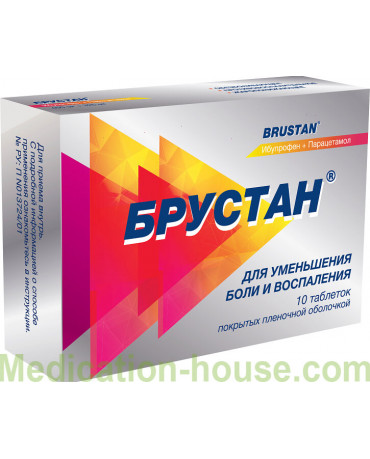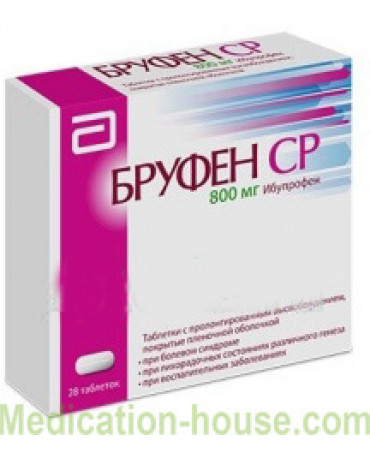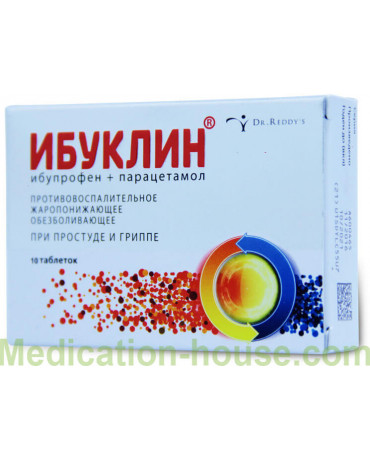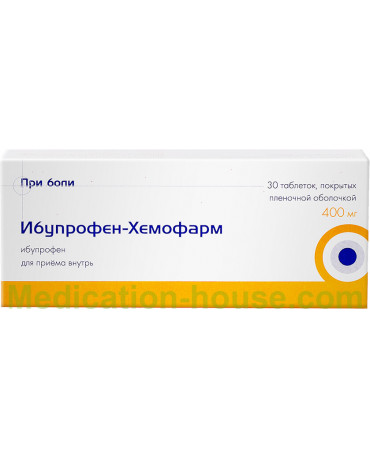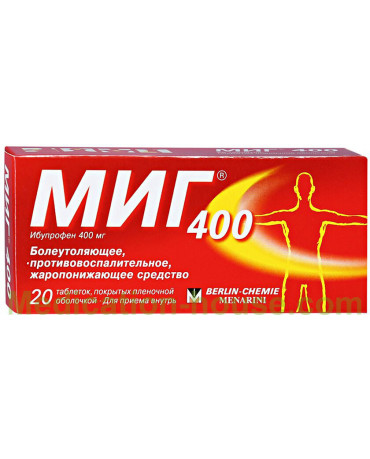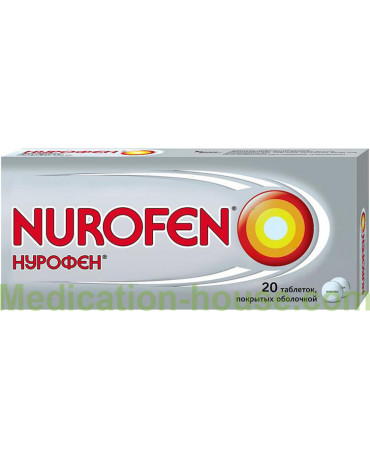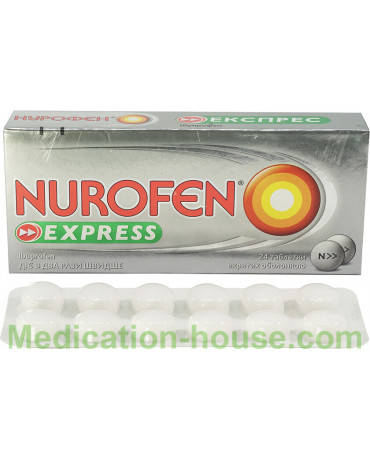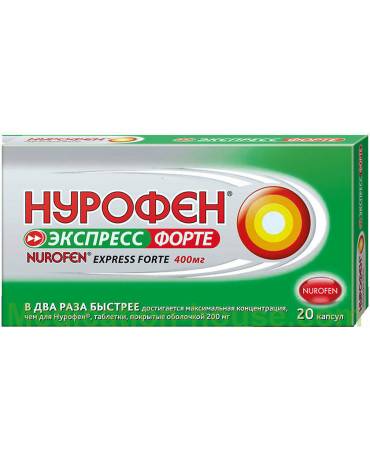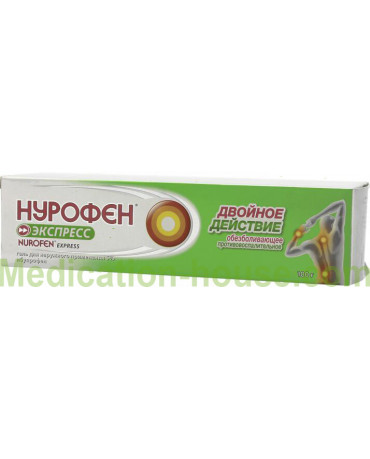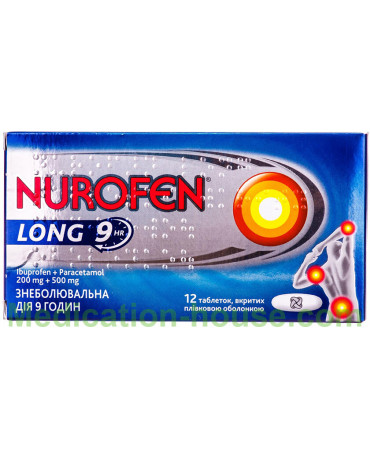Nurofen Forte instruction
You can buy Nurofen Forte here
Composition
One coated tablet contains:
active ingredient: ibuprofen 400 mg;
excipients: croscarmellose sodium 60 mg, sodium lauryl sulfate 1 mg, sodium citrate 87 mg, stearic acid 4 mg, colloidal silicon dioxide 2 mg.
shell composition: carmellose sodium 1.4 mg, talc 66 mg, acacia gum 1.2 mg, sucrose 232.2 mg, titanium dioxide 2.8 mg, macrogol 6000 0.4 mg, red ink [Opacode S-1-15094 ] (shellac 41.49%, iron dye red oxide (E172) 31%, butanol * 14%, isopropanol * 7%, propylene glycol 5.5%, ammonia aqueous 1%, simethicone 0.01%).
* Solvents evaporated after the printing process.
Description
White sugar-coated round biconvex tablets with an overprint of red color Nurofen 400 on one side of the tablet.
Pharmacotherapeutic group: nonsteroidal anti-inflammatory drug (NSAIDs).
Pharmacodynamics
The mechanism of action of ibuprofen, a derivative of propionic acid from the group of nonsteroidal anti-inflammatory drugs (NSAIDs), is due to the inhibition of the synthesis of prostaglandins - mediators of pain, inflammation and hyperthermia. Indiscriminately blocks cyclooxygenase 1 (COX-1) and cyclooxygenase 2 (COX-2), as a result of which it inhibits the synthesis of prostaglandins. It has a quick directional effect against pain (pain reliever), antipyretic and anti-inflammatory effect. In addition, ibuprofen reversibly inhibits platelet aggregation. The analgesic effect of Nurofen Forte lasts up to 8 hours.
Pharmacokinetics
Absorption - high, quickly and almost completely absorbed from the gastrointestinal tract (GIT). After taking Nurofen Forte on an empty stomach, the maximum concentration (Cmax) of ibuprofen in the blood plasma is reached after 45 minutes. Taking Nurofen Forte with food can increase the time to reach the maximum concentration (TCmax) up to 1-2 hours. Communication with plasma proteins - 90%. Slowly penetrates into the cavity of the joints, lingers in the synovial fluid, creating in it greater concentrations than in the blood plasma. In the cerebrospinal fluid found lower concentrations of ibuprofen compared with blood plasma. After absorption, about 60% of the pharmacologically inactive R-form slowly transforms into the active S-form. Metabolized in the liver. The half-life (T1 / 2) is 2 hours. Excreted by the kidneys (in unchanged form, not more than 1%) and, to a lesser extent, with bile.
In limited studies, ibuprofen has been detected in breast milk at very low concentrations.
Indications for use
Nurofen Forte is used for headache, migraine, toothache, painful menstruation, neuralgia, back pain, muscle pain, rheumatic pain and joint pain; as well as in a feverish state with influenza and colds.
Contraindications
Hypersensitivity to ibuprofen or any of the components that make up Nurofen Forte.
A complete or incomplete combination of asthma, recurrent nasal polyposis and paranasal sinuses, and intolerance to acetylsalicylic acid or other NSAIDs (including a history of).
Erosive and ulcerative diseases of the gastrointestinal tract (including gastric ulcer and duodenal ulcer, Crohn's disease, ulcerative colitis) or ulcerative bleeding in the active phase or in history (two or more confirmed episodes of peptic ulcer or ulcerative bleeding).
A bleeding or perforation of a gastrointestinal ulcer in history, provoked by the use of NSAIDs.
Severe heart failure (NYHA class IV - New York Heart Association classification).
Severe liver failure or liver disease in the active phase.
Severe renal failure (creatinine clearance <30 ml / min), confirmed hyperkalemia.
Decompensated heart failure; period after coronary artery bypass surgery.
Cerebrovascular or other bleeding.
Fructose intolerance, glucose-galactose malabsorption, sucrase-isomaltase deficiency.
Hemophilia and other bleeding disorders (including hypocoagulation), hemorrhagic diathesis.
Pregnancy (III trimester).
Children's age up to 12 years.
Carefully
In the presence of conditions indicated in this section, before using Nurofen Forte should consult a doctor.
The simultaneous reception of other NSAIDs, the presence in the history of a single episode of gastric ulcer and duodenal ulcer or ulcerative bleeding of the gastrointestinal tract; gastritis, enteritis, colitis, Helicobacter pylori infection, ulcerative colitis; bronchial asthma or allergic diseases in the acute stage or in the anamnesis - the development of bronchospasm is possible; systemic lupus erythematosus or mixed connective tissue disease (Sharpe syndrome) - increased risk of aseptic meningitis; chickenpox; renal failure, including dehydration (creatinine clearance less than 30-60 ml / min), nephrotic syndrome, liver failure, liver cirrhosis with portal hypertension, hyperbilirubinemia, hypertension and / or heart failure, cerebrovascular diseases, blood diseases of unclear etiology ( leukopenia and anemia), severe somatic diseases, dyslipidemia / hyperlipidemia, diabetes mellitus, peripheral artery disease, smoking, frequent use of alcohol, simultaneous use of l drugs that may increase the risk of ulcers or bleeding, in particular, oral glucocorticosteroids (including prednisolone), anticoagulants (including warfarin), selective serotonin reuptake inhibitors (including citalopram, fluoxetine, paroxetine, sertraline) or antiplatelet agents (including acetylsalicylic acid, clopidogrel), pregnancy I-II trimester, breastfeeding period, old age.
Use during pregnancy and during breastfeeding
Use of Nurofen Forte in the III trimester of pregnancy is contraindicated. The use of Nurofen Forte in the I-II trimesters of pregnancy should be avoided; if necessary, Nurofen Forte should be consulted with a doctor.
There is evidence that small amounts of ibuprofen can penetrate into breast milk without any negative consequences for the health of the infant, so usually with a short-term use of the need to stop breastfeeding does not occur. If necessary, long-term use of Nurofen Forte should consult a doctor to decide whether to stop breastfeeding for the period of use of Nurofen Forte.
Dosage and administration
For oral administration. Patients with hypersensitivity of the stomach are advised to take Nurofen Forte with meals.
For short term use only. Carefully read the instructions before taking Nurofen Forte.
Adults and children over 12 years of age inside 1 tablet (400 mg) up to 3 times per day. Tablets should be taken with water.
The interval between taking pills should be at least 6 hours.
The maximum daily dose is 1200 mg (3 tablets). The maximum daily dose for children from 12 to 18 years old is 800 mg (2 tablets).
If while taking Nurofen Forte for 2-3 days the symptoms persist or worsen, it is necessary to stop treatment and consult a doctor.
Side effects of Nurofen Forte
The risk of side effects can be minimized if Nurofen Forte is taken in a short course, at the minimum effective dose needed to eliminate the symptoms.
In older people, there is an increased incidence of adverse reactions on the background of the use of NSAIDs, especially gastrointestinal bleeding and perforations, in some cases with a fatal outcome.
Side effects are predominantly dose-dependent.
The following adverse reactions were observed with short-term ibuprofen in doses not exceeding 1200 mg / day (3 tablets). In the treatment of chronic conditions and long-term use may cause other adverse reactions.
The frequency of adverse reactions was estimated based on the following criteria: very frequent (≥ 1/10), frequent (from ≥ 1/100 to <1/10), infrequent (from ≥ 1/1000 to <1/100), rare ( from ≥ 1/10 000 to <1/1000), very rare (<1/10 000), the frequency is unknown (there is not enough data to estimate the frequency).
Violations of the blood and lymphatic system
Very rare: disorders of blood formation (anemia, leukopenia, aplastic anemia, hemolytic anemia, thrombocytopenia, pancytopenia, agranulocytosis). The first symptoms of such disorders are fever, sore throat, superficial oral ulcers, flu-like symptoms, severe weakness, bleeding from the nose and subcutaneous hemorrhages, hemorrhages and hemorrhages of unknown etiology.
Immune system disorders
Infrequent: hypersensitivity reactions - nonspecific allergic reactions and anaphylactic reactions, reactions of the respiratory tract (bronchial asthma, including its exacerbation, bronchospasm, shortness of breath, dyspnea), skin reactions (itching, urticaria, purpura, Quincke edema, exfoliative and bullosa mathema , including toxic epidermal necrolysis (Lyell's syndrome), Stevens-Johnson syndrome, erythema multiforme), allergic rhinitis, eosinophilia.
Very rare: severe hypersensitivity reactions, including swelling of the face, tongue and larynx, shortness of breath, tachycardia, hypotension (anaphylaxis, angioedema or severe anaphylactic shock).
Disorders of the gastrointestinal tract
Infrequent: abdominal pain, nausea, dyspepsia (including heartburn, bloating).
Rare: diarrhea, flatulence, constipation, vomiting.
Very rare: peptic ulcer, perforation or gastrointestinal bleeding, melena, bloody vomiting, in some cases with a lethal outcome, especially in elderly patients, ulcerative stomatitis, gastritis.
Frequency unknown: exacerbation of colitis and Crohn's disease.
Disorders of the liver and biliary tract
Very rare: abnormal liver function, increased activity of "liver" transaminases, hepatitis and jaundice.
Kidney and urinary tract disorders
Very rare: acute renal failure (compensated and decompensated), especially with prolonged use, in combination with increased concentration of urea in the blood plasma and the appearance of edema, hematuria and proteinuria, nephritic syndrome, nephrotic syndrome, papillary necrosis, interstitial nephritis, cystitis.
Nervous system disorders
Infrequent: headache.
Very rare: aseptic meningitis.
Violations of the cardiovascular system
The frequency is unknown: heart failure, peripheral edema, with long-term use increased risk of thrombotic complications (for example, myocardial infarction), increased blood pressure.
Violations of the respiratory system and mediastinal organs
Frequency unknown: bronchial asthma, bronchospasm, shortness of breath.
Laboratory values
hematocrit or hemoglobin (may decrease)
bleeding time (may increase)
plasma glucose concentration (may decrease)
creatinine clearance (may decrease)
plasma creatinine concentration (may increase)
liver transaminase activity (may increase)
If you experience side effects, you should stop taking Nurofen Forte and consult a doctor.
Overdose
In children, overdose symptoms may occur after taking a dose in excess of 400 mg / kg body weight. In adults, the dose-dependent effect of overdose is less pronounced. The half-life of Nurofen Forte in overdose is 1.5-3 hours.
Symptoms: nausea, vomiting, pain in the epigastric region or, rarely, diarrhea, tinnitus, headache and gastrointestinal bleeding. In more severe cases, there are manifestations of the central nervous system: drowsiness, rarely - excitement, convulsions, disorientation, coma. In cases of severe poisoning, metabolic acidosis and an increase in prothrombin time, renal failure, liver tissue damage, a decrease in blood pressure, respiratory depression and cyanosis can develop. Patients with bronchial asthma may worsen this disease.
Treatment: symptomatic, with the mandatory provision of airway patency, monitoring of ECG and major vital signs until the patient's condition is normalized. Oral administration of activated charcoal or gastric lavage for 1 hour after administration of a potentially toxic dose of ibuprofen is recommended. If ibuprofen has already been absorbed, an alkaline drink may be given to remove the acidic ibuprofen derivative by the kidneys, forced diuresis. Frequent or prolonged seizures should be stopped by intravenous administration of diazepam or lorazepam. With the worsening of asthma, the use of bronchodilators is recommended.
Interaction Nurofen Forte with other drugs
The simultaneous use of ibuprofen with the following drugs should be avoided:
Acetylsalicylic acid: with the exception of low doses of acetylsalicylic acid (not more than 75 mg per day), prescribed by a doctor, because the combined use may increase the risk of side effects. With simultaneous use of ibuprofen reduces the anti-inflammatory and antiplatelet effect of acetylsalicylic acid (it is possible to increase the incidence of acute coronary insufficiency in patients receiving small doses of acetylsalicylic acid as an antiplatelet agent after starting ibuprofen).
Other NSAIDs, in particular, selective COX-2 inhibitors: the simultaneous use of two or more drugs from the NSAID group should be avoided due to the possible increase in the risk of side effects.
With caution to apply simultaneously with the following drugs:
Anticoagulants and thrombolytic drugs: NSAIDs can enhance the effect of anticoagulants, in particular, warfarin and thrombolytic drugs.
Antihypertensive drugs (ACE inhibitors and angiotensin II antagonists) and diuretics: NSAIDs may decrease the effectiveness of drugs in these groups. In some patients with impaired renal function (for example, in patients with dehydration or in elderly patients with impaired renal function), the simultaneous administration of ACE inhibitors or angiotensin II antagonists and cyclooxygenase inhibiting agents can lead to deterioration of renal function, including the development of acute renal failure (usually reversible). These interactions should be considered in patients taking coxibs concurrently with ACE inhibitors or angiotensin II antagonists. In this regard, the combined use of the above funds should be prescribed with caution, especially in the elderly. It is necessary to prevent dehydration in patients, as well as to consider the possibility of monitoring renal function after the start of such combined treatment and periodically in the future. Diuretics and ACE inhibitors can increase the nephrotoxicity of NSAIDs.
Glucocorticosteroids: an increased risk of gastrointestinal ulcers and gastrointestinal bleeding.
Antiplatelet agents and selective serotonin reuptake inhibitors: an increased risk of gastrointestinal bleeding.
Cardiac glycosides: the simultaneous appointment of NSAIDs and cardiac glycosides can lead to aggravation of heart failure, a decrease in the glomerular filtration rate and an increase in the concentration of cardiac glycosides in the blood plasma.
Lithium preparations: there are data on the likelihood of increasing the concentration of lithium in the blood plasma during the use of NSAIDs.
Methotrexate: there are data on the likelihood of increasing the concentration of methotrexate in the blood plasma during the use of NSAIDs.
Cyclosporine: an increased risk of nephrotoxicity with the simultaneous appointment of NSAIDs and cyclosporine.
Mifepristone: NSAID should be started no earlier than 8-12 days after taking mifepristone, since NSAIDs can reduce the effectiveness of mifepristone.
Tacrolimus: with the simultaneous appointment of NSAIDs and tacrolimus may increase the risk of nephrotoxicity.
Zidovudine: simultaneous use of NSAIDs and zidovudine can lead to increased hematotoxicity. There is evidence of an increased risk of hemarthrosis and hematomas in HIV-positive patients with hemophilia who received joint treatment with zidovudine and ibuprofen.
Quinol antibiotics: in patients receiving joint treatment of NSAIDs and quinolone antibiotics, the risk of seizures may increase.
Myelotoxic drugs: increased hematotoxicity.
Cefamundol, cefoperazone, cefotetan, valproic acid, plicamycin: an increase in the incidence of hypoprothrombinemia.
Drugs that block tubular secretion: a decrease in excretion and an increase in plasma concentration of ibuprofen.
Inductors of microsomal oxidation (phenytoin, ethanol, barbiturates, rifampicin, phenylbutazone, tricyclic antidepressants): an increase in the production of hydroxylated active metabolites, an increase in the risk of developing severe intoxications.
Inhibitors of microsomal oxidation: reducing the risk of hepatotoxic action.
Oral hypoglycemic drugs and insulin, sulfonylurea derivatives: enhanced action of drugs.
Antacids and colestyramine: reduced absorption.
Uricosuric drugs: reducing the effectiveness of drugs.
Estrogens, ethanol: increased risk of side effects.
Caffeine: increased analgesic effect.
special instructions
It is recommended to take Nurofen Forte in the shortest possible course and in the minimum effective dose necessary to eliminate the symptoms. If it is necessary to take Nurofen Forte for more than 10 days, you must consult a doctor.
In patients with asthma or allergic disease in the acute stage, as well as in patients with a history of bronchial asthma / allergic disease, Nurofen Forte can provoke bronchospasm. The use of the drug in patients with systemic lupus erythematosus or mixed connective tissue disease is associated with an increased risk of aseptic meningitis.
During long-term treatment, it is necessary to control the picture of peripheral blood and the functional state of the liver and kidneys. When symptoms of gastropathy appear, careful monitoring is shown, including esophagogastroduodenoscopy, complete blood count (hemoglobin determination), fecal occult blood test. If necessary, determine the 17-ketosteroids drug should be canceled 48 hours before the study. During the treatment period, ethanol is not recommended.
Patients with renal insufficiency should consult with a physician before using Nurofen Forte, because there is a risk of deterioration of the functional state of the kidneys.
Patients with hypertension, including a history and / or chronic heart failure, should consult a physician before using Nurofen Forte, because the drug can cause fluid retention, high blood pressure and edema.
Patients with uncontrolled arterial hypertension, NYHA class II-III congestive heart failure, coronary heart disease, diseases of the peripheral arteries and / or cerebrovascular diseases should be prescribed ibuprofen only after careful evaluation of the benefit-risk ratio, and the use of high doses of ibuprofen should be avoided (≥ 2400 mg / day).
The use of NSAIDs in patients with chickenpox may be associated with an increased risk of developing severe purulent complications of infectious and inflammatory skin diseases and subcutaneous fat (eg, necrotizing fasciitis). In this regard, it is recommended to avoid the use of Nurofen Forte for chickenpox.
Information for women planning a pregnancy: Nurofen Forte inhibits cyclooxygenase and prostaglandin synthesis, affects ovulation, impairing female reproductive function (reversible after discontinuation of treatment).
Influence on ability to steer vehicles, mechanisms
Patients who notice dizziness, drowsiness, lethargy or visual impairment while taking ibuprofen, should avoid driving vehicles or driving mechanisms.
Release form
400 mg coated tablets.
On 6 or 12 tablets in the blister (PVC / PVDH / aluminum).
On 1 or 2 blisters (on 6 or 12 tablets) place in a cardboard pack together with the instruction for application.
Storage conditions
Store at a temperature not higher than 25 ° С.
Keep out of the reach of children.
Shelf life - 3 years.
Do not use expired drug.
Terms of sell
You can buy Nurofen Forte without a prescription.


